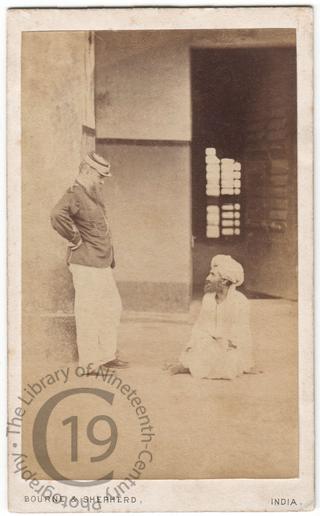
Abdullah
A carte-de-visite portrait of Abdullah, who on the steps of the town hall in Calcutta on 21 September 1871 murdered John Paxton Norman, the acting Chief Justice in the High Court at Fort William in Bengal. Text printed verso in three different languages - English, Bengali and Urdu - asks for ‘any information regarding the antecedents of this Man.’ Despite the last paragraph of the early report quoted below, and despite the lack of any proof, all sorts of wild rumours were soon floating about and the authorities came to fear that Abdullah had acted as part of some wider Wahhabi conspiracy, hence the search for his associates.
According to ‘Telegraphic Intelligence’ in The Times (22 September 1871): ‘Mr Justice Norman, the Deputy Chief Justice, died at 1 o’clock this morning, at a house [in fact the premises of the publishers Thacker, Spink & Co] near the Court to which he was taken when wounded. Mrs Norman was present to the last. One wound was in the abdomen, and the other on the left shoulder, between the spine and the bladebone. When struck he fell, but recovered, and ran, then stopped and flung a brick at the murderer, who was promptly captured.
‘The murderer was examined yesterday, and made no defence. In reply to a question, he said that ‘earth is sunk below the water, and the men have gone up to the sky; the dog is eating the wall.’ He is believed to be feigning madness. [According to another report, he was out of his head on ‘bhang’ but was perfectly lucid once its effects had worn off.] He had ascertained previously at what time the court opened, and waited on the steps until Mr Justice Norman arrived, when he struck him with a tapering Goorkha knife.
‘There seems nothing political in the murder. There is no reason to suppose Wahabeeism has anything to do with the murder, and there is no apparent connexion with the Punjab murders. It is rumoured Mr Justice Norman had decided a private suit against the murderer.’
Over the following weeks many letters appeared in The Times debating whether or not ‘Indian Mussulmans [are] considerately treated and well and wisely governed’ (20 October 1871).
Abdullah’s trial on 28 September lasted two hours; he was, perhaps inevitably, sentenced to be executed two weeks later. According to a report in the Calcutta Englishman (quoted in the Tasmanian newspaper The Mercury on 2 January 1872): ‘He was exceedingly calm – almost insolent, talking to the witnesses and police in a very cool manner, twisting the end of his moustachios and staring around him at the people in the court.’ His execution was postponed but eventually took place on 4 November 1871. According to a report in The Times (7 November 1871): ‘The assassin of Judge Norman was hanged and his body burnt on Saturday. His body was burnt by men of the lowest caste.’
A day earlier the Homeward Mail from India, China and the East (6 November 1871) had announced: ‘A telegram which has just come to hand announces the execution of ABDULLAH, the murderer of Chief Justice NORMAN, and the subsequent burning of the wretched man’s body. There are rumours by the mail of a clue to the antecedents of ABDULLAH through the exhibition of his photograph, and it was thought that some important revelations about Mohamedan subjects might be the result. Nothing new has, however, transpired.’ It seems that the authorities eventually reached the conclusion that the murderer had indeed acted alone.
Photographed by Bourne and Shepherd of India.
Code: 126624




